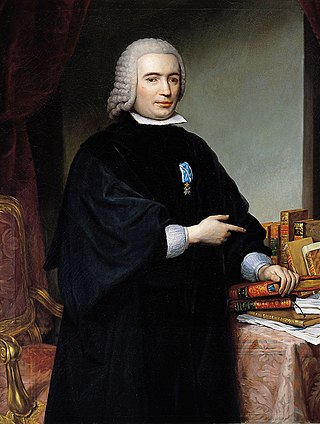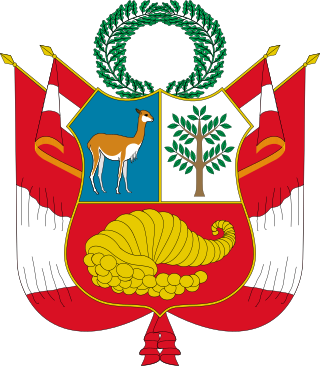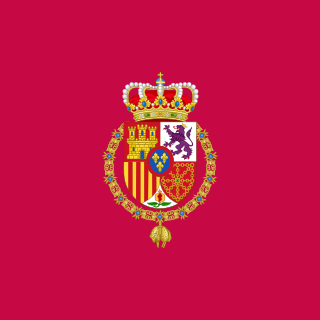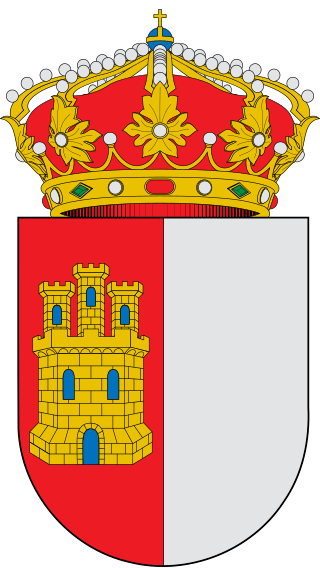Castile or Castille is a territory of imprecise limits located in Spain. The invention of the concept of Castile relies on the assimilation of a 19th-century determinist geographical notion, that of Castile as Spain's centro mesetario with a long-gone historical entity of diachronically variable territorial extension.

Pedro Gutiérrez de Valdivia or Valdiva was a Spanish conquistador and the first royal governor of Chile. After serving with the Spanish army in Italy and Flanders, he was sent to South America in 1534, where he served as lieutenant under Francisco Pizarro in Peru, acting as his second in command.

John I was King of Castile and León from 1379 until 1390. He was the son of Henry II and of his wife Juana Manuel of Castile.

The coat of arms of the Argentine Republic or Argentine shield was established in its current form in 1944, but has its origins in the seal of the General Constituent Assembly of 1813. It is supposed that it was chosen quickly because of the existence of a decree signed on February 22 sealed with the symbol. The first mention of it in a public document dates to March 12 of that same year, in which it is stated that the seal had to be used by the executive power, that is, the second triumvirate. On April 13 the National Assembly coined the new silver and gold coins, each with the seal of the assembly on the reverse, and on April 27 the coat of arms became a national emblem. Although the coat of arms is not currently shown on flags, the Buenos Aires-born military leader Manuel Belgrano ordered to paint it over the flag he gave to the city of San Salvador de Jujuy, and during the Argentine War of Independence most flags had the coat of arms.

The coat of arms of Spain represents Spain and the Spanish nation, including its national sovereignty and the country's form of government, a constitutional monarchy. It appears on the flag of Spain and it is used by the Government of Spain, the Cortes Generales, the Constitutional Court, the Supreme Court, and other state institutions. Its design consists of the arms of the medieval kingdoms that would unite to form Spain in the 15th century, the Royal Crown, the arms of the House of Bourbon, the Pillars of Hercules and the Spanish national motto: Plus Ultra. The Monarch, the heir to the throne and some institutions like the Senate, the Council of State and the General Council of the Judiciary have their own variants of the coat of arms.

Pedro Rodríguez de Campomanes y Pérez, 1st Count of Campomanes, was a Spanish statesman, economist, and writer who was Minister of the Treasury in 1760. He was an adherent of the position that the state held supremacy over the Church, often called Erastianism. Campomanes was part of the government of Charles III. A staunch anti-Jesuit, one of the biggest foes of the order, Campomanes was the main driving force behind their expulsion.

The Battle of Nájera, also known as the Battle of Navarrete, was fought on 3 April 1367 to the northeast of Nájera, in the province of La Rioja, Castile. It was an episode of the first Castilian Civil War which confronted King Peter of Castile with his half-brother Count Henry of Trastámara who aspired to the throne; the war involved Castile in the Hundred Years' War. Castilian naval power, far superior to that of France or England, encouraged the two polities to take sides in the civil war, to gain control over the Castilian fleet.

The Coat of arms of Peru is the national symbolic emblem of Peru. Four variants are used: the Coat of arms per se ; the National Coat of arms, or National Shield ; the Great Seal of the State ; and the Naval Coat of arms.

The Pinzón brothers were Spanish sailors, pirates, explorers and fishermen, natives of Palos de la Frontera, Huelva, Spain. Martín Alonso, Francisco Martín and Vicente Yáñez, participated in Christopher Columbus's first expedition to the New World and in other voyages of discovery and exploration in the late 15th and early 16th centuries.

The Royal Standard of Spain is the official flag of the King of Spain. It comprises a crimson square, traditional colour of both Castilian and Spanish monarchs, with the coat of arms of the King in the center. It is raised over the official royal residence in Madrid, the Palacio de la Zarzuela and other Spanish royal sites, when the monarch is in residence and displayed on his official car as small flag. The current flag was adopted when Felipe VI acceded the throne as King of Spain on 19 June 2014. The Royal Standard is regulated by Rule 2 of Royal Decree 527/2014, 20 June, an amendment to Title II of Spanish Royal Decree 1511/1977 adopting Flags, Standards, Guidons, Insignia and Emblems Regulation.

María Alfonso Téllez de Meneses, known as María de Molina, was queen consort of Castile and León from 1284 to 1295 by marriage to Sancho IV of Castile, and served as regent for her minor son Ferdinand IV and later her grandson Alfonso XI of Castile (1312-1321).

Jerónimo de Alderete y Mercado was a Spanish conquistador who was later named governor of Chile, but died before he could assume his post.

Villamelendro is a town belonging to the municipality of Villasila de Valdavia, in the region of Vega-Valdavia. It is located in the transition area between the Natural Park Montaña Palentina and the Tierra de Campos in the province Spain of Palencia, on the upper side of the Triangle formed by Saldaña, Carrión de los Condes and Herrera de Pisuerga and located at the foot of the route Jacobea that linked San Vicente de la Barquera with Carrión de los Condes through the Royal way of La Valdavia.

The 2011 Castilian-Leonese regional election was held on Sunday, 22 May 2011, to elect the 8th Cortes of the autonomous community of Castile and León. All 84 seats in the Cortes were up for election. The election was held simultaneously with regional elections in twelve other autonomous communities and local elections all throughout Spain.

The Battle of the Morcuera, was a battle of the Spanish Reconquista that took place in the Hoz de la Morcuera between the municipalities of Foncea and Bugedo nearby the city of Miranda de Ebro on 9 August, 865. The battle was fought between the combined Christian troops of the Kingdom of Castile and the Kingdom of Asturias under Rodrigo of Castile and the Muslim forces of the Emirate of Cordoba under Muhammad I of Córdoba. The battle resulted in a victory for the Cordobans and a general retreat in the overall Reconquista process.
Abraham Seneor or Abraham Senior was a Sephardic rabbi, banker, politician, patriarch of the Coronel family and last Crown rabbi of Castile, a senior member of the Castilian hacienda. In 1492, at the age of 80, he converted to Roman Catholicism, taking the name Ferran, Fernan or Fernando Pérez Coronel, thus founding the noble lineage of Coronel.

The coat of arms of the Castilla–La Mancha is described in the Spanish Law 1 of 30 June 1983, the Law of the coat of arms of Castilla-La Mancha Region and further regulated by Decree 132 of 5 July 1983, approving the official design of the coat of arms of Castilla-La Mancha and Decree 115 of 12 November 1985, supplementing Decree 132/1983.

The coat of arms of Castile was the heraldic emblem of its monarchs. Historian Michel Pastoureau says that the original purpose of heraldic emblems and seals was to facilitate the exercise of power and the identification of the ruler, due to what they offered for achieving these aims. These symbols were associated with the kingdom, and eventually also represented the intangible nature of the national sentiment or sense of belonging to a territory.

Coat of arms of Buenos Aires Province was declared official on the 19th of October 1935, by Law 4351. It is similar to the arms of Argentina and has its origins in the seal of the General Constituent Assembly of 1813.


















